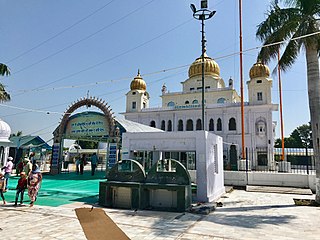
The following outline is provided as an overview of and topical guide to Sikhism:

The khanda is the symbol of the Sikh faith, that attained its current form around the first decade of the 20th century.

The Nishan Sahib is a Sikh triangular flag made of cotton or silk cloth, with a tassel at its end. The word, Nishan means symbol, and the flag is hoisted on a tall flagpole, outside most Gurdwaras. The flagpole itself, covered with fabric, ends with a two-edged dagger (khanda) on top. The emblem on the flag is also known as Khanda, which depicts a double-edged sword called a khanda (☬) in the centre, a chakkar which is circular, and flanked by two single-edged swords, or kirpans.

Anandpur Sahib, sometimes referred to simply as Anandpur, is a city in Rupnagar district (Ropar), on the edge of Shivalik Hills, Indian state of Punjab. Located near the Sutlej River, the city is one of the most sacred places in Sikhism, being the place where the last two Sikh Gurus lived, Guru Teg Bahadur Ji and Guru Gobind Singh Ji. this is the place where Guru Gobind Singh Ji founded the Khalsa Panth in 1699. The city is home to Kesgarh Sahib Gurdwara, one of the five Takhts in Sikhism.

Patiala district is one of the twenty two districts in the state of Punjab in north-west India.
Panj Pyare, is the collective name given to five Sikh men:

Fatehgarh Sahib is a town and a sacred pilgrimage site of Sikhism in the north west Indian state of Punjab. It is the headquarters of Fatehgarh Sahib district, located about 5 kilometres (3.1 mi) north of Sirhind. Fatehgarh Sahib is named after Fateh Singh, the 7 year old son of Guru Gobind Singh who was seized and buried alive along with his 9 year old brother Zoravar Singh, by the Mughal Army under the orders of commander Wazir Khan during the ongoing Muslim-Sikh war of early 18th century. The town experienced major historical events after the martyrdom of the sons in 1705, with repeated change of control between the Sikh and Muslim rulers.
Sahibzada Zorawar Singh was the third of Guru Gobind Singh's four sons. He and his younger brother, Sahibzada Fateh Singh are among the most hallowed martyrs in Sikhism.
Malwa is a region of India in the south-east of the state of Punjab and parts of Haryana and Rajasthan, between the Sutlej and Yamuna rivers.

Baba Deep Singh (1682–1757) is revered among Sikhs as one of the most hallowed martyrs in Sikhism and as a highly religious person. He is remembered for his sacrifice and devotion to the teachings of the Sikh Gurus. Baba Deep Singh was the first head of Misl Shaheedan Tarna Dal – an order of the Khalsa military established by Nawab Kapur Singh, the then head of Sharomani Panth Akali Buddha Dal.
Fatehgarh Churian is a city and a municipal council in Gurdaspur district in the state of Punjab, India.

Sirhind-Fatehgarh is a city and a municipal council in the Fatehgarh Sahib district in the Indian state of Punjab.

The khanda is a double-edge straight sword originating from the Indian subcontinent. It is often featured in religious iconography, theatre and art depicting the ancient history of India. It is a common weapon in Indian martial arts. Khanda often appears in Hindu, Jain, Buddhist and Sikh scriptures and art.

Shaheedi Sabha is three-day annual religious congregation (get-together) organised every year in December at Gurdwara Fatehgarh Sahib, in the Fatehgarh Sahib district of Punjab, India to pay homage to the martyrdom of Chhotte Sahibzade Baba Zorawar Singh and Baba Fateh Singh, the youngest sons of the 10th sikh guru Guru Gobind Singh.

The Haveli Todar Mal popularly known as Jahaz Haveli or Jahaz Mahal is the 17th century residence (haveli) of Todar Mal, a Jain businessman from Sirhind, and an ardent follower of the Sikh Gurus, who became the diwan in the court of Nawab Wazir Khan, the Governor of Sirhind, under Mughal Empire. Today, he is most remembered for defying the Mughals by arranging for the cremation of young martyred sons of Guru Gobind Singh and his mother.
Gurdwara Jyoti Sarup is a noted Gurdwara, situated in the city of Fatehgarh Sahib, Sirhind, Punjab, India.

Gurdwara Fatehgarh Sahib is a Sikh gurdwara or place of worship in the city of Fatehgarh Sahib in the Indian state of Punjab. The gurdwara marks the 1710 conquest of the city by the Sikhs under the leadership of Banda Bahadur. Sikhs captured the area and razed the fort built by Ferozshah Tughlaq to the ground.
Nandpur Kalaur is a conurbation of two villages in Bassi Pathana Tehsil in Fatehgarh Sahib District in Punjab State in India. The two villages are administrated separately but are physically contiguous with the main demarkation between them being the Bassi Pathana Road which passes between them.











